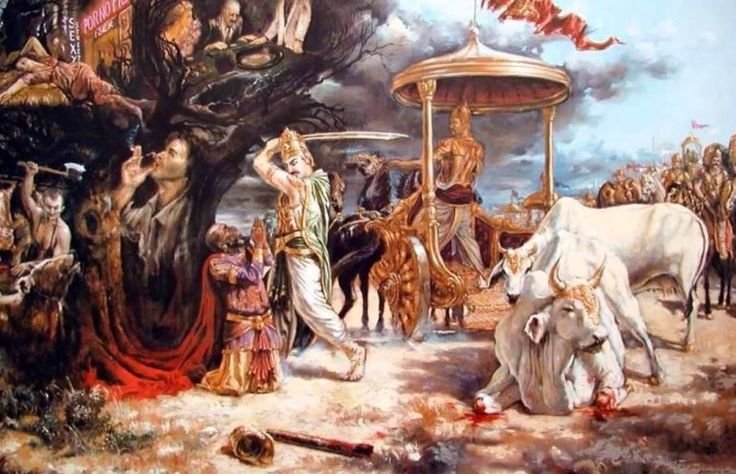Kalki Avatar: The Tenth and Final Avatar of Lord Vishnu
The stories of Hindu mythology have always been rich in symbolism, prophecy, and timeless wisdom. Among the most enigmatic figures is Kalki Avatar, the prophesied tenth and final incarnation of Lord Vishnu. Known as the destroyer of darkness and the harbinger of a new age, Kalki Avatar holds a special place in the Hindu judgement day narrative.
In this article, we explore the profound significance of Kalki Avatar, delving into the prophecies, stories, and cultural relevance. With a clear eye and a steady voice, let us walk together into the heart of this compelling mythology.
What is Kalki Avatar?
Kalki, derived from the Sanskrit word “Kal,” means “time” or “eternity.” It also refers to the destroyer of foulness. As the final avatar of Lord Vishnu, Kalki is believed to descend upon the Earth during the end of Kali Yuga, the age of darkness and ignorance.
The concept of Dashavatara, or the ten avatars of Vishnu, is central to Hindu belief. Each avatar represents a divine intervention in human affairs, ensuring the balance of Dharma (righteousness). Kalki, as the tenth avatar, symbolizes the end of the old and the beginning of the new.
In Hindu cosmology, time is cyclical, divided into four Yugas: Satya, Treta, Dvapara, and Kali. Each Yuga reflects the moral and spiritual state of humanity. The Kali Yuga, where we reside today, is marked by moral decay, dishonesty, and chaos. Kalki’s advent is the divine promise of renewal.
Kalki Avatar Father And Mother Name
The Kalki Purana, an ancient scripture, dedicates itself entirely to the prophecy of Kalki. According to this text, Kalki will be born to Vishnuyasha, a virtuous Brahmin, and Sumati in the village of Shambhala. Riding a white horse with a blazing sword, he will annihilate the forces of evil and restore Dharma.
Kalki Avatar According To Vishnu Puran
The Vishnu Purana and Bhagavata Purana also speak of Kalki. They describe his arrival as a turning point in the cosmic cycle. He will end the tyranny of unrighteous rulers, destroy adharma (unrighteousness), and prepare the ground for Satya Yuga, the age of truth.
These scriptures present Kalki not just as a warrior but as a beacon of hope. His advent serves as a reminder that even in the darkest of times, divinity will guide humanity toward light.
The Appearance and Role of Kalki Avatar
The scriptures vividly describe Kalki Avatar’s appearance and the powerful symbolism attached to it. Kalki is depicted as a majestic figure, riding a white horse named Devadatta. In his hand, he wields a fiery sword that gleams like the sun, ready to cut through the darkness of ignorance and evil.
The white horse is a symbol of purity and swift action. Its presence signifies that Kalki’s mission will be both decisive and transformative. The fiery sword, on the other hand, represents divine knowledge and justice, tools to restore balance and righteousness to the world.
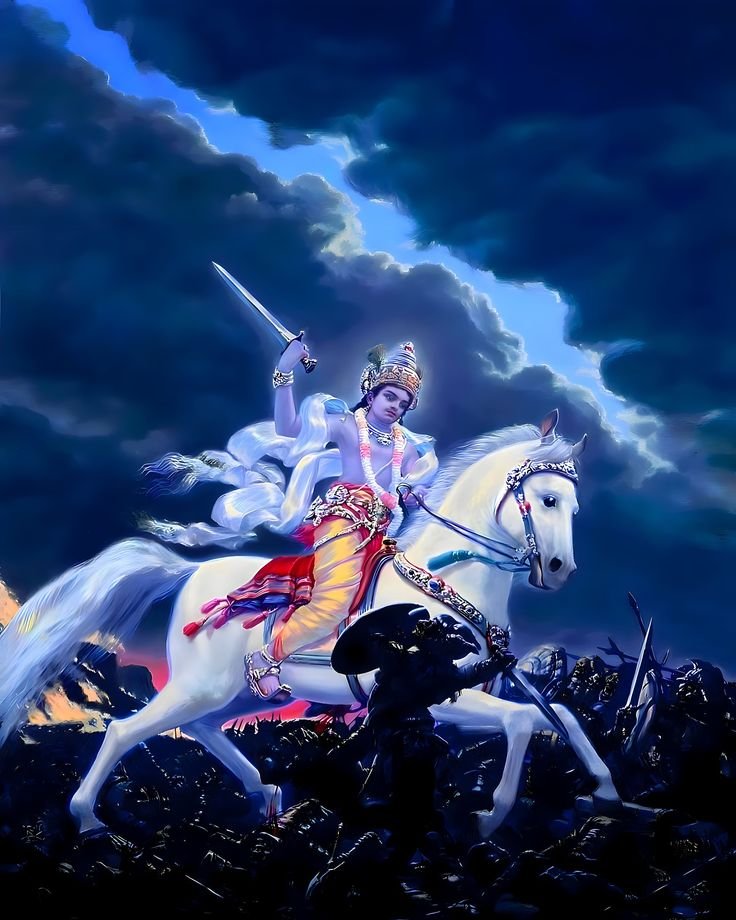
Why Kalki Avatar Will Born
Kalki Avatar’s purpose is not one of mere destruction but transformation. The Kali Yuga, the darkest age of humanity, is characterized by moral corruption, greed, and a general disregard for Dharma.
The Kalki Purana states that people in this era will no longer value truth, respect for elders, or the sanctity of relationships. Humanity, weighed down by materialism, will need divine intervention.
Kalki will destroy unrighteous rulers, cleanse the Earth of evil, and reestablish the principles of Dharma. His role is akin to a cosmic reset, preparing humanity for the dawn of a new golden age, the Satya Yuga.
Kalki Avatar Of Lord Vishnu
Kalki’s story is not just a tale of divine wrath. It carries a profound philosophical message. The cycle of Yugas reflects the universal law of change—everything moves from creation to preservation to destruction, only to be reborn. Kalki Avatar embodies this cycle, representing the eternal promise of renewal.
The Bhagavata Purana beautifully captures this essence:
Bhagavata Purana, 12.2.32:
“यदा यदा हि धर्मस्य ग्लानिर्भवति भारत | अभ्युत्थानमधर्मस्य तदात्मानं सृजाम्यहम् || १२-२-३२ ||”
“When the practices taught in the Vedas and institutes of law have nearly ceased, and the close of the Kali age shall be near, a portion of that Divine Being who exists in His own spiritual nature shall descend upon Earth.”
This passage encapsulates the hope and certainty of Kalki’s arrival. He comes not as an invader but as a healer, resetting the cosmic balance.
Symbolism in Kalki Avatar Story
Kalki’s tale resonates deeply beyond the religious framework. For many, it symbolizes the fight against personal and societal darkness. The white horse can be seen as the individual’s conscience, guiding them toward truth, while the fiery sword represents the courage to cut through illusion and falsehood.
In a world riddled with modern challenges—corruption, inequality, and environmental degradation—Kalki’s story inspires action. It urges humanity to reflect on its own role in maintaining Dharma, individually and collectively.
The Context of Kalki Avatar in Modern Times
Kalki Avatar’s prophecy, though rooted in ancient scriptures, continues to spark curiosity and debate in the modern era. While some view it as a literal event—a divine being descending to Earth—others interpret it as a symbolic narrative representing humanity’s collective journey toward moral and spiritual renewal.
Symbolic Interpretations of Kalki Avatar
In today’s context, many scholars and spiritual thinkers consider Kalki Avatar a metaphor for transformation. The Kali Yuga, they argue, is not just a cosmic phase but a reflection of inner struggles. The darkness of this age symbolizes ignorance, greed, and the loss of moral values.
Kalki’s fiery sword is interpreted as the weapon of knowledge, cutting through the illusions of the material world. The white horse, a representation of purity, symbolizes the need for clarity and righteousness in thought and action.
This perspective encourages individuals to see themselves as agents of change. Rather than waiting for divine intervention, humanity is urged to embody the virtues Kalki represents—truth, courage, and justice—to combat the evils of the age.
Debates Around Kalki Avatar Meaning
For those who adhere to a literal understanding, the arrival of Kalki Avatar is not a question of “if” but “when.” These beliefs are deeply intertwined with the cyclical nature of Yugas as described in Hindu cosmology.
According to the Kalki Purana, specific conditions signal Kalki’s advent, including widespread immorality, degradation of traditional values, and the rise of tyrannical rulers. Many believe these conditions resonate with the present times, fueling speculation that the prophecy is nearing fulfillment.
Skeptics, however, argue that such interpretations can lead to complacency. They warn against passively waiting for Kalki’s arrival while ignoring the pressing need for self-improvement and societal reform.
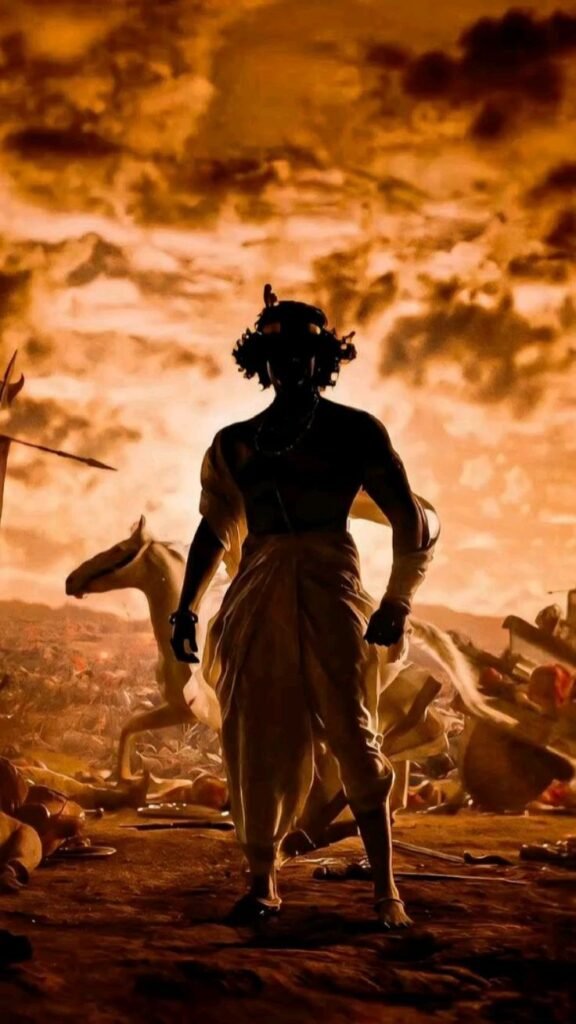
When Will Kalki Avatar Born On Earth
The tales of Kalki Avatar are not merely mythological narratives; they are windows into the collective hopes and fears of humanity. These stories, steeped in symbolism, provide rich insights into the cultural and devotional practices of Hindus across the world.
Kalki Avatar Birth Place
According to the Kalki Purana, Kalki will be born in the village of Shambhala, to a pious Brahmin couple, Vishnuyasha and Sumati. This setting, serene and untouched by the chaos of Kali Yuga, reflects the purity needed for the advent of a savior. Shambhala is often interpreted as a symbolic place—a state of being where truth and righteousness remain uncorrupted.
The moment of Kalki’s birth is described as one of cosmic significance. Nature, which had been subdued by the weight of sin, comes alive. Rivers flow freely, flowers bloom, and the air carries the scent of renewal. This imagery underlines the harmony that Kalki’s presence is destined to restore.
The Training of Kalki Avatar
As the story unfolds, Kalki is said to be trained in the art of war and strategy by none other than Parashurama, another avatar of Vishnu. Parashurama, known for his martial prowess and discipline, equips Kalki with the skills needed to confront the forces of darkness.
This phase of Kalki’s life emphasizes the importance of preparation and learning. It conveys the idea that even divinity requires the right tools and training to succeed in its mission.
The Battle Against Evil
One of the most captivating aspects of Kalki’s tale is the great battle that marks the culmination of his mission. Mounted on his white horse, Devadatta, and wielding his fiery sword, Kalki charges into a world dominated by adharma.
The battle is not just physical; it is a spiritual confrontation. Kalki faces unrighteous rulers, demonic forces, and the collective ignorance of humanity. His victory symbolizes the triumph of light over darkness and truth over deceit.
Kalki Avatar Photo As Per Kalki Puran
The imagery of Kalki Avatar has inspired countless artistic and devotional works. From traditional paintings and sculptures to modern cinematic depictions, Kalki is often portrayed as a heroic figure exuding power and divinity.
In temple architecture, Kalki is occasionally depicted alongside the other nine avatars of Vishnu, completing the Dashavatara sequence. His portrayal often highlights the dynamic energy of his mission—an upright posture, blazing sword, and the majestic white horse.
Culturally, Kalki has also become a figure of devotion for those seeking hope and renewal. Chanting mantras and performing rituals in honor of Kalki are believed to invoke his blessings, offering spiritual strength to overcome personal and societal challenges.
Predictions and Timing of Kalki Avatar’s Birth
The birth of Kalki Avatar is one of the most debated aspects of Hindu eschatology. While the scriptures provide vivid descriptions of his mission, they are less specific about the exact timing of Kalki’s birth. This ambiguity has led to various interpretations, blending astrological, philosophical, and symbolic insights.
When Will Kalki Avatar Be Born?
According to Hindu cosmology, we are currently in the Kali Yuga, the fourth and final age of the cosmic cycle. The Kali Yuga is believed to last for 432,000 years, and as per traditional calculations, only around 5,000 years have elapsed since its onset. This suggests that the arrival of Kalki Avatar may still be far into the future.
However, the scriptures emphasize that Kalki will descend at a time when humanity reaches its lowest moral and spiritual state. The Vishnu Purana (book 4, chapter 24) states:
“जब जब धर्मं हिनस्ति जालं, लोकस्य च पापकर्मणां, तदा तदा भवत्येव गर्भं, कल्कि: युगस्य अन्ते।”
“When greed, falsehood, and deceit become commonplace, and humanity is driven by selfish desires, the Lord will take form as Kalki to restore order.”
For many, these descriptions feel strikingly relevant to the current state of the world, leading to speculation that the prophecy could unfold sooner than anticipated.
Kalki Avatar Birth Chart
The concept of Yugas is deeply intertwined with Hindu astrology. The transition from Kali Yuga to Satya Yuga is marked by cosmic alignments and shifts in planetary energies. While these transitions are gradual, Kalki’s advent is seen as the divine catalyst that accelerates this change.
- Birth Place: Shambhala village, a sacred and spiritual place known for divine intervention in Hindu scriptures.
- Birth Date: On the 12th full moon night at the peak of Kali Yuga, signifying the darkest time before the dawn of the Satyug.
- Nakshatra: Aswini Nakshatra, the lunar mansion symbolizing healing, renewal, and divine power—traits closely associated with Kalki’s mission.
- Family: Born into a Brahmin family, Kalki will be the son of Vishnuyasha and Sumati.
- Education: Kalki will get warfare training from Lord Parshuram, preparing him for his fight against Kali.
Some astrologers link the prophecy to celestial phenomena, such as rare planetary alignments or the appearance of certain comets. These interpretations add a layer of mystery to the already intriguing narrative of Kalki Avatar.
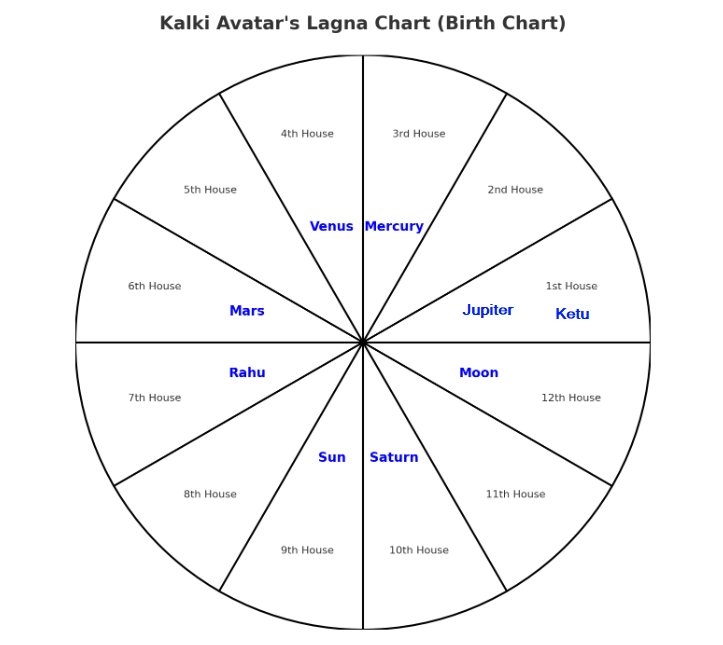
Here is the Lagna Chart (Birth Chart) for Kalki Avatar, illustrating the planetary positions in the 12 houses. Each house is marked with its designation, and the planets are positioned as per the interpretation of Vedic astrology.
Misconceptions About Kalki Avatar’s Arrival
Despite the rich symbolism in the scriptures, the idea of Kalki Avatar is often misunderstood. Some interpret the prophecy as an immediate event, expecting Kalki to physically descend amidst chaos. Others believe that Kalki may already be present, working discreetly to prepare humanity for transformation.
While these views reflect diverse interpretations, it is essential to remember that the core message of Kalki Avatar transcends literal timelines. It serves as a reminder of the cyclical nature of life and the inevitability of renewal after darkness.
What Kalki Avatar Teaches Us About Time and Change
Beyond its religious significance, Kalki Avatar’s prophecy offers profound philosophical lessons. It underscores the inevitability of change and the importance of individual and collective effort in navigating it.
As the destroyer of darkness, Kalki inspires us to confront our inner demons—ignorance, greed, and fear—and embrace the light of knowledge and righteousness. The prophecy encourages us to be proactive in restoring balance, reminding us that transformation often begins from within.
Relevance of Kalki Avatar in Hinduism and Global Spirituality
The story of Kalki Avatar is not merely a tale of divine intervention but a profound exploration of humanity’s need for moral and spiritual renewal. Rooted in Hinduism, it carries universal themes that resonate across religions, philosophies, and cultures.
The Importance of Kalki Avatar in Hinduism
In Hindu eschatology, Kalki represents the ultimate protector and restorer of Dharma (righteousness). While each of Vishnu’s avatars fulfills a specific purpose, Kalki stands apart as the bringer of total transformation. His arrival symbolizes the end of a degenerate age and the beginning of a new cycle, embodying hope, justice, and divine compassion.
For devout Hindus, Kalki’s promise serves as a source of strength during challenging times. Chanting prayers and mantras dedicated to Kalki, such as the “Kalki Gayatri Mantra,” is believed to invoke divine guidance.
ॐ काल्कि महायोगिनि महाक्रूर महाक्रोध महापराक्रमी महावीर महाशक्ते महाप्रभावाय सर्वजनविघ्ननाशिनि महादेव्यै नमः।
In a broader sense, the message of Kalki Avatar inspires introspection and encourages believers to embody virtues such as courage, honesty, and selflessness. The teachings emphasize that the fight against adharma begins within and must be carried outward into the world.
Parallels in Other Religions
The themes of destruction and renewal found in Kalki’s story are echoed in several religious and cultural traditions:
- Kalki in Christianity: The Second Coming of Christ closely parallels Kalki Avatar’s prophecy. Both figures are seen as messianic saviors who will defeat evil, restore peace, and establish a new era of righteousness.
- Kalki in Islam: In Islamic eschatology, the Mahdi is a prophesied figure who will appear at the end of times to guide humanity and uphold justice, much like Kalki.
- Kalki in Zoroastrianism: The concept of Saoshyant, a savior figure who will renew the world, aligns with the transformative role of Kalki.
These parallels suggest that the yearning for renewal and divine justice is universal. Kalki Avatar, though deeply rooted in Hinduism, transcends cultural and religious boundaries, offering a shared narrative of hope and moral awakening.
Symbolism in Global Context
In the modern world, Kalki’s story can be seen as a call to action. The evils of Kali Yuga—corruption, greed, and environmental degradation—are challenges faced by all humanity. Kalki’s tale reminds us that collective effort is needed to overcome these crises.
Rather than waiting for divine intervention, individuals and societies are encouraged to take inspiration from Kalki’s mission. By embracing the values of truth, compassion, and justice, humanity can work toward its own renewal.
A Modern Interpretation: Lessons for Today
Kalki Avatar’s story is more than mythology; it’s a mirror reflecting humanity’s struggles and potential. It teaches us that even in the darkest times, change is possible. The fiery sword of Kalki is not just a weapon—it’s a symbol of knowledge, reminding us to confront ignorance with wisdom.
The white horse, Devadatta, represents purity and action. It urges us to approach challenges with clarity, guided by moral and spiritual principles. These symbols, timeless in their relevance, inspire us to be agents of transformation in our own lives and communities.
The Enduring Message of Kalki Avatar
The prophecy of Kalki Avatar stands as one of the most profound and hopeful narratives in Hinduism. It embodies the cyclical nature of time and reassures humanity that even in the darkest age, divinity will intervene to restore balance.
Kalki’s story is not confined to religious belief—it serves as a timeless metaphor for transformation. It encourages us to confront challenges with courage, pursue knowledge, and embody the principles of Dharma in our daily lives. Whether interpreted literally or symbolically, the message is clear: renewal begins with action, and light will always overcome darkness.
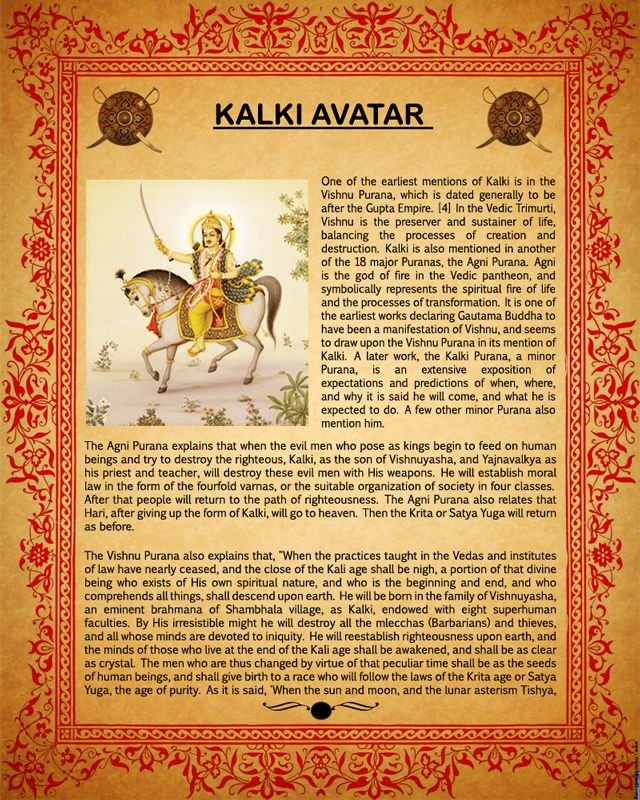
Frequently Asked Questions About Kalki Avatar
1. Who is Kalki Avatar?
Kalki Avatar is the prophesied 10th avatar of Lord Vishnu. He is believed to appear at the end of Kali Yuga, the age of darkness, to destroy evil and restore righteousness.
2. Where will Kalki Avatar be born?
According to the Kalki Purana, Kalki will be born in the village of Shambhala to a Brahmin couple, Vishnuyasha and Sumati.
3. What is the purpose of Kalki Avatar?
Kalki’s purpose is to end the reign of adharma (unrighteousness) and establish a new era, the Satya Yuga, characterized by truth, morality, and spiritual awakening.
4. Is Kalki Avatar a literal or symbolic figure?
Interpretations vary. Some view Kalki as a literal incarnation who will physically descend to Earth, while others see him as a symbolic representation of humanity’s potential for renewal and transformation.
5. How is Kalki Avatar relevant today?
Kalki’s story inspires individuals and societies to combat ignorance, greed, and moral decay. It encourages proactive efforts to restore balance and uphold righteousness in the modern world.
Embodying the Spirit of Kalki
The tale of Kalki Avatar is not just a prophecy—it’s a call to action. In a world grappling with moral and ecological crises, the lessons of Kalki remain strikingly relevant. His fiery sword reminds us of the power of knowledge and justice, while his white horse urges us to act with purity and purpose.
As we navigate the challenges of Kali Yuga, let us draw inspiration from Kalki’s mission. By embracing truth, courage, and compassion, we can play our part in bringing light to a world overshadowed by darkness. Kalki may symbolize divine intervention, but his message is clear: transformation begins with us.
Key Takeaways from the Article
- Kalki Avatar represents the divine promise of renewal during Kali Yuga.
- His mission is to destroy evil, restore Dharma, and initiate the Satya Yuga.
- The prophecy of Kalki carries universal themes of transformation and justice, resonating across cultures and religions.
- Modern interpretations of Kalki’s story highlight the importance of proactive efforts to overcome societal and personal challenges.
By understanding and embodying the essence of Kalki Avatar, we can contribute to creating a more just, balanced, and enlightened world.


